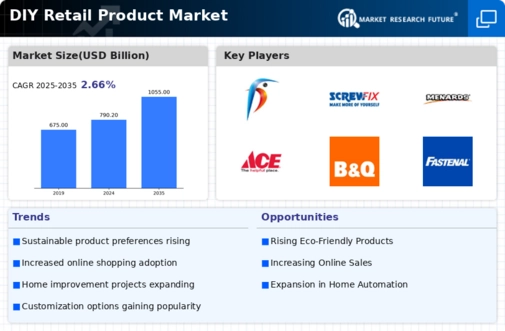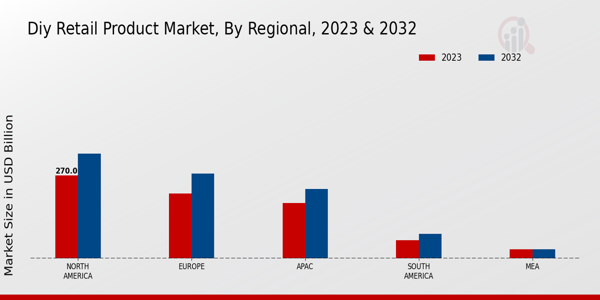Market Growth Projections
The Global DIY Retail Product Market Industry is projected to experience substantial growth over the coming years. With a market value of 790.2 USD Billion in 2024, it is anticipated to reach 1055.0 USD Billion by 2035, reflecting a compound annual growth rate (CAGR) of 2.66% from 2025 to 2035. This growth trajectory indicates a robust demand for DIY products, driven by various factors such as consumer interest in home improvement, sustainability, and technological advancements. The market's expansion is likely to create new opportunities for retailers and manufacturers alike, shaping the future of the DIY landscape.
Expansion of E-Commerce Platforms
The rise of e-commerce platforms plays a crucial role in shaping the Global DIY Retail Product Market Industry. Online shopping provides consumers with unprecedented access to a diverse range of DIY products, often at competitive prices. This convenience encourages more individuals to undertake DIY projects, as they can easily source materials and tools from the comfort of their homes. The ongoing expansion of logistics and delivery services further enhances this trend, making it easier for consumers to receive their purchases promptly. Consequently, the market is likely to witness significant growth as it adapts to the evolving retail landscape.
Technological Advancements in DIY Tools
Technological innovations significantly influence the Global DIY Retail Product Market Industry. The introduction of smart tools and advanced materials enhances the DIY experience, making projects more accessible and efficient for consumers. For instance, tools equipped with digital interfaces or augmented reality features allow users to visualize their projects before execution. This technological integration not only improves user satisfaction but also attracts a broader demographic, including younger consumers. As the industry adapts to these advancements, it is poised for sustained growth, with a projected CAGR of 2.66% from 2025 to 2035.
Sustainability and Eco-Friendly Products
Sustainability emerges as a pivotal driver within the Global DIY Retail Product Market Industry. Consumers increasingly prioritize eco-friendly materials and sustainable practices in their DIY projects. This shift is indicative of a broader societal trend towards environmental consciousness. Retailers are responding by offering a range of sustainable products, which not only cater to consumer preferences but also align with regulatory frameworks promoting sustainability. The market's evolution towards greener options is likely to enhance its appeal, potentially contributing to its growth trajectory as it approaches 1055.0 USD Billion by 2035.
Growing Consumer Interest in Home Improvement
The Global DIY Retail Product Market Industry experiences a notable surge in consumer interest towards home improvement projects. This trend is driven by a desire for personalized living spaces and increased homeownership rates. As individuals invest in their homes, the market is projected to reach 790.2 USD Billion in 2024. This growth reflects a shift in consumer behavior, where DIY projects are not merely hobbies but essential aspects of home maintenance and enhancement. The rise of online platforms and social media further fuels this interest, providing inspiration and resources for DIY enthusiasts, thereby expanding the market's reach.
Influence of Social Media and DIY Communities
Social media platforms and online DIY communities significantly impact the Global DIY Retail Product Market Industry. These platforms serve as vital sources of inspiration, tutorials, and peer support for DIY enthusiasts. The sharing of project ideas and success stories fosters a sense of community, encouraging more individuals to engage in DIY activities. This social influence not only drives consumer interest but also shapes purchasing decisions, as users often seek products endorsed by their peers. As these communities continue to flourish, they are expected to contribute to the market's growth, reinforcing the DIY culture globally.
























Leave a Comment